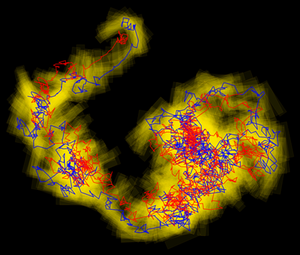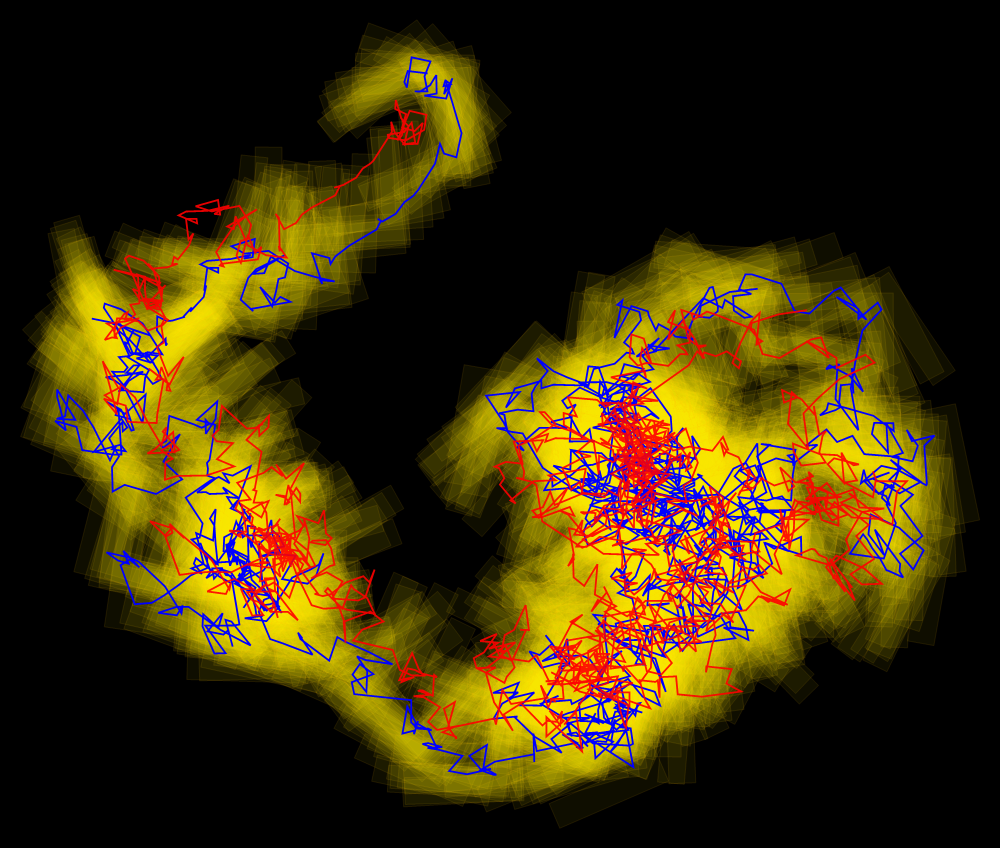Boomerangs Diffuse Differently than Spheres
A small particle floating in water is normally nudged in all directions with equal probability, thanks to jostling on all sides by molecules of fluid. But a team reporting in Physical Review Letters demonstrated that if the particle is shaped like a boomerang, one direction is preferred over others, at least initially. This behavior might be exploited in the future to design microscopic particles that deliver drugs or that self-assemble into complex materials.
In 1905 Einstein showed that the so-called Brownian motion of microscopic grains in water resulted from buffeting by water molecules. He predicted that the distance a Brownian particle travels would be proportional to the square root of the time elapsed, and confirmation of this prediction provided strong evidence that matter is indeed composed of atoms and molecules.
If the Brownian particle is an ellipsoid, then it will “look” bigger from some directions than from others, so that the average number of molecular impacts won’t be the same in all directions. Nonetheless, because of the symmetric shape, these differences even out. Recent studies have shown that the end result is much the same as for spheres: averaging over many trials leads to no net motion in any particular direction [1].
Qi-Huo Wei of Kent State University in Ohio and his colleagues have now found that there is a favored direction for a more profoundly nonspherical shape, a boomerang. The researchers used photolithography to make boomerangs from a polymeric material, with arms about micrometers long, joined at an apex angle of . They used video microscopy to track the particles suspended in water and confined to the -micrometer-wide space between two transparent plates. The motion was essentially two-dimensional.
The researchers found that for periods of up to about one minute, each particle showed a bias, moving preferentially in the direction exactly halfway between its arms (in the smaller-angle direction). Over longer times, the particle motion became randomized as the boomerang was bumped and rotated by water molecules.
The distance traveled by a particle can be defined in two ways. A spherical particle moves away from its starting point according to Einstein’s square-root law; this distance is called the root-mean-square displacement. But if the same experiment is performed many times from the same starting position, the particle goes in a different direction on each run, and the average displacement for all of them—the so-called mean displacement (MD)—will be zero.
While Brownian ellipsoids also have a zero MD, the team found that boomerang particles do not. That is, if a boomerang is repeatedly tested with the same starting orientation, it will tend to drift in roughly the same direction each time—the direction of the line bisecting the arms. At first the MD increases with time, but after a few minutes it plateaus as the boomerang is jostled away from its preferred direction. At that stage, the boomerang comes to behave more like an ellipsoidal Brownian particle.
According to Wei and colleagues’ theoretical analysis, the preferred direction is the only one in which the boomerang doesn’t tend to rotate as it moves forward. In all other directions, unequal molecular impacts between the two arms make the particle turn and deviate from its initial path.
“This is a fascinating paper,” says Alexander Morozov, a specialist in the flow of complex fluids at the University of Edinburgh, UK. “The very fact that one can design a shape that would lead to directed motion” is new and has many potential uses, he says. For example, the directed motion, perhaps in combination with magnetic fields, could be part of a system to deliver drugs to targeted cells in the body. He imagines this would be for short-distance motion within tissues, not the blood stream, and he cautions that such systems are still far in the future. Morozov says the effect might also be used for materials that assemble themselves.
Wei and his colleagues are now considering a technique where particle orientation is maintained with electric or magnetic fields, which would extend the time period for directed motion and possibly allow particles or even molecules to be sorted by shape. Initial calculations support this idea, but it is still preliminary, says Wei.
–Philip Ball
Philip Ball is a freelance science writer in London. His latest book is How Life Works (Picador, 2024).
References
- Y. Han, A. M. Alsayed, M. Nobili, J. Zhang, T. C. Lubensky, and A. G. Yodh, “Brownian Motion of an Ellipsoid,” Science 314, 626 (2006)





